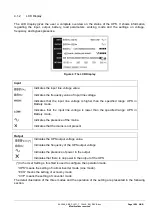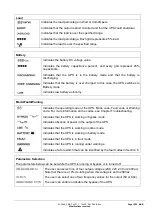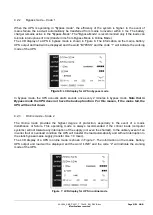
04-3598_ABB_PVA11_T_1-3kVA_EN_REV-B.doc
Page 7/29 ABB
Modifications reserved
1.4
Inquiries
Address inquiries about the UPS to the local office or agent authorized by the supplier. Please note the
type code and the serial number of the equipment and contact your nearest agent authorized by the
supplier. The Code and the serial no. are shown on the nameplate of the product. For further information
on troubleshooting, go to Section 6.
1.5
Operation
Refer to instruction before operating the UPS.
Do not remove the enclosure of the UPS. This system is to be serviced by qualified service personnel
only.
Do not disconnect the mains cable of the UPS or the building wiring socket during operation as this
would remove the ground to the UPS and of all connected loads.
In order to fully disconnect the UPS, press the OFF button. Only after the UPS is shutdown, disconnect
the mains load.
Ensure that no liquid or other foreign objects enter the UPS.
The socket-outlet should be installed near the equipment and should be easily accessible.
ISOLATE THE UNINTERRUPTIBLE POWER SUPPLY (UPS) BEFORE WORKING ON ITS
CIRCUIT.
For cabling, remove the protective panel only after disconnecting the terminal connections and use the
appropriate wires as indicated in Table 1.
UPS
Input Wire
Output Wire
3 kVA
(with
inbuilt
batteries)
NA
AWG 8, 90
C copper wire and 12 lb-in Torque force when
connecting to the terminal blocks
3 kVA (no
in-built
batteries)
AWG 12, 90
C copper wire
and 4.4 lb-in Torque force
when connecting to terminal
block
AWG 12, 90
C copper wire and 12 lb-in Torque force when
connecting to the terminal blocks
Table 1: Input and Output Wiring
1.6
Maintenance, servicing and faults
Repairs may be carried out only by qualified maintenance personnel as the UPS operates with
hazardous voltages.
WARNING!
EVEN AFTER THE UNIT IS DISCONNECTED FROM THE MAINS POWER
SUPPLY, COMPONENTS INSIDE THE UPS ARE STILL CONNECTED TO
THE BATTERY WHICH ARE POTENTIALLY DANGEROUS.
Before carrying out any kind of service and/or maintenance, disconnect the batteries. Verify that no
current is present and no hazardous voltage exists in the capacitor or BUS capacitor terminals. Batteries
must be replaced only by qualified personnel.








































